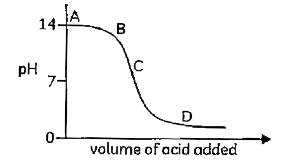The graph given below depicts a neutralization reaction (acid + alkali → salt + water). The pH of a solution changes as we add excess of acid to an alkali.

Which letter denotes the area of the graph where both acid and salt are present ?
A
A
B
B
C
C
D
D
Text Solution
The correct Answer is:D
Neutralization reaction is the reaction between an acid (pH < 7) and a base (pH > 7) to form a salt and water.
When excess of acid is added to an alkali, the solution changes from basic to acidic. In the graph the areas marked A,B and C have pH > 7 and therefore depict basic medium Whereas, the region marked D has pH < 7 and therefire shows acidic medium and is the correct answer.
|
Similar Questions
Knowledge Check
Which salt gives the most acidic 0.1 M solution in water ?
ANaClBNaNO3CNH4ClDNH4NO2When a salt of weak acid and weak base is dissolved in water, the pH of the resulting solution will be :
A7Bdepends on the value of KaandKbCless than 7Dgreater than 7Acids generally react with alkalies to form salt and water. Which one of the following bases, on reaction with acid, does not produce water along with salt?
AAmmoniaBSodium bicarbonateCSodium hydroxideDCalcium hydroxide
What name is given to the reaction in which an acid reacts with a base to form salt and water?
View SolutionSolution A is a strong acid
Solution B is a weak alkali
Solution C is a strong alkali
Which solution contains solute molecules in addition to water molecules ?
View SolutionWhich one of the following salts give an acidic solution in water ?
View SolutionAcids generally react with alkalies to form salt and water. Which one of the following bases, on reaction with acid, does not produce water along with salt?
View SolutionWhich one of the following salts give an acidic solution in water ?
View Solution
